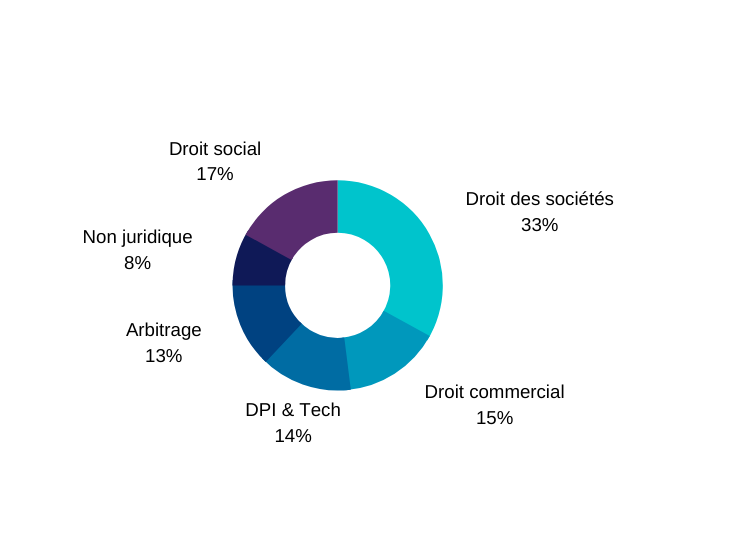TransLex in 2020 by the Numbers: Growth, Precision, and Linguistic Challenges
Against all odds, 2020 turned out to be a year of growth for TransLex, with revenue up by 25%. Here’s a data-driven look back at a year that was remarkable in many ways.
I. A Consistent Client Base
Our clients — without whom we would either be doing something else or nothing at all! There was no major change this year: in 2020 we served around one hundred clients, 21% being the legal departments of multinational corporations and 70% law firms (75% of them international), most often instructing us on behalf of their own clients. In France, our clients are primarily based in Paris; abroad, they are mostly located in London, Brussels, and Luxembourg.
We have also received a growing number of inquiries from private individuals seeking translations of personal documents (around 9% of requests, covering passports, driver’s licenses, birth certificates, etc.), likely due to improved SEO visibility of our website. However, we decline these requests: they simply do not take advantage of the highly specialized expertise we bring to the table.
Roughly 16% of new inquiries came from referrals, while 67% originated from existing clients. This confirms an industry reality: word of mouth is still the most effective source of new business. This was all the more welcome since we undertook no outbound commercial efforts in 2020, and spontaneous requests from search engines remain rare and almost never convert (the extreme price sensitivity is simply not compatible with our high-end positioning).
II. Breakdown of Requests
A. By Practice Area
Serving legal professionals, we primarily handle legal documents. Corporate law (M&A, PE, etc.) remains our core business (33%), followed by labor law (17%), commercial law (15%), IP/IT (14%), and, for the first time in any significant way, arbitration (13%).
We also occasionally handle non-legal documents (8% in 2020) when included in case files (financial statements, exhibits, etc.), accepting them on a case-by-case basis depending on feasibility. We know our limits, and we don’t claim to do everything.

B. By Day of the Week and Time of Day
Requests were evenly distributed across weekdays (19.4%–22.2% from Monday to Thursday), except for Friday (13.2%). Weekends remained marginal (1.8% on Saturday, 1.4% on Sunday).
As for hours of the day:
-
27.6% of requests came between 8 a.m. and noon,
-
7.6% between noon and 2 p.m.,
-
34.9% between 2 p.m. and 6 p.m.,
-
18.5% between 6 p.m. and 8 p.m.,
-
9.1% between 8 p.m. and midnight,
-
2.3% between midnight and 8 a.m.
.
This contrasts with prior years, when late evenings and weekends were especially heavy. Could this be the influence of remote work and a better work-life balance — contrary to much of what the press suggests? We cannot say for sure, but the shift has not altered our 24/7/365 availability. Even if requests arrive mostly during business hours, urgency is still the rule in nearly 75% of cases.
C. By Project Size
Smaller projects are somewhat more frequent (17.2% under €1,000, declining linearly to 10,000, and dropping to 6.2% above €20,000) and are confirmed much more often (quotes under €1,000 are accepted 77.8% of the time, versus 42% for projects over €5,000).
We cannot tell whether unconfirmed projects are abandoned or awarded to lower-cost providers, so drawing firm conclusions is difficult. Still, across all quotes issued, only 52% were confirmed. These stable year-to-year figures reflect our positioning (premium services, pricing accordingly) and our selective offering (specialized legal disciplines, limited language pairs, exclusively professional clientele).
Notably, this year we handled our most complex project to date: about 2,000 hours of work over one month, across three language pairs and three time zones — a true linguistic and logistical challenge!
D. By Language Pair
No surprises here: French and English dominate given our clientele, expertise, and location.
-
FR → EN: 37%
-
EN → FR: 36%
Trailing behind are Spanish, German, Italian, and, much further back, Chinese.
The largest multilingual project of the year involved GDPR documentation to be translated into 14 languages!
III. Our Team
On the translation side, we worked with nearly 50 linguists in 2020, including teams of up to 20 on the most demanding assignments (such as the one mentioned above). Our core group of half a dozen trusted, long-standing collaborators — who will recognize themselves and to whom we owe an immense debt of gratitude — covered two-thirds of our needs. This is a true luxury, given the extreme rarity of the expertise we require, and it ensures the consistency of our services.
As for applications from new translators (excluding spam), we received around 50 and, after testing, retained only two — with whom we hope to build long-term collaborations. This may seem low, but in some years we retain none. We are therefore heading into 2021 with cautious optimism!
---
A special word of thanks to the attorneys and staff at August Debouzy, Bredin Prat, DLA Piper, Gibson Dunn, Rothschild & Co, White & Case, Quinn Emanuel, Latham & Watkins, Kirkland & Ellis, and Uber, who once again entrusted us with challenging assignments throughout 2020.
Other recent posts in the "Articles" section

Translating Assignation, Plainte, and Requête: A US Practitioner's Guide to French Procedural Documents

The Deceptive Simplicity of "Legal Entity": Navigating Translation Pitfalls in Cross-Border Legal Practice

Translating an Assignation, Injonction, or Sommation: What You Need to Know?
Site information
TransLex
34 rue Guillaume Tell
75017 Paris
info[@]translex.com
© TransLex. All rights reserved.
Powered by Knowlex Management.